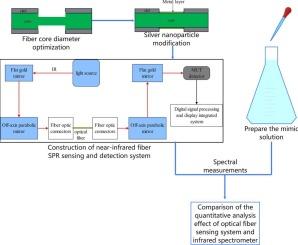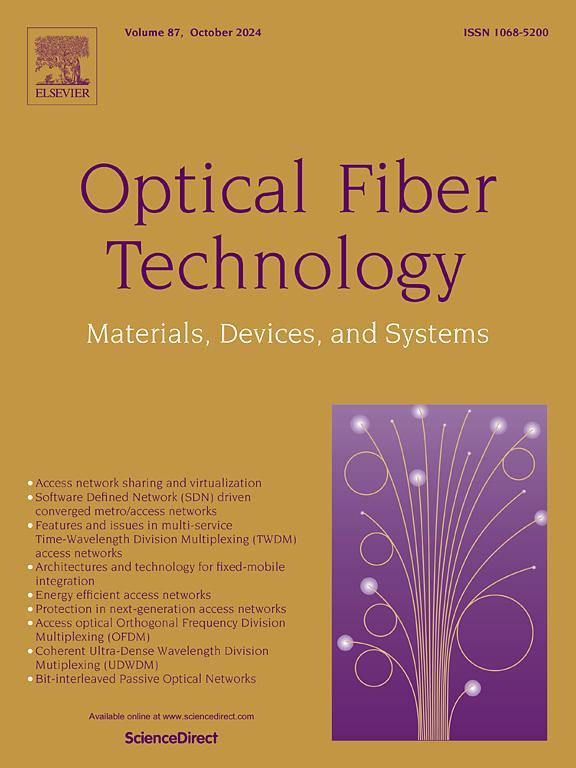Quantitative analysis of albumin and glucose based on near-infrared fibre-optic SPR sensing
IF 2.7
3区 计算机科学
Q2 ENGINEERING, ELECTRICAL & ELECTRONIC
引用次数: 0
Abstract
Blood component analysis is a critical tool for disease diagnosis. Infrared spectroscopy, combined with fibre optic sensing, offers rapid, non-destructive, and accurate blood biochemical analysis; however, traditional devices face challenges in miniaturisation, cost, and noise interference. This study developed a near-infrared fibre optic SPR sensing system to address these issues, optimising fibre processing and coating for enhanced performance in clinical diagnostics. Fibres were etched with HF acid to vary core diameters, and silver nanoparticles were modified on fibre surfaces under different pH conditions. A multimode fibre-based SPR system was constructed for the quantitative analysis of albumin and glucose, and the results were compared with those obtained using a spectrometer. Fibres etched for 80 min with silver nanoparticles (approximately 45 nm) in a pH nine environment achieved optimal detection, enhancing sensor sensitivity via surface plasmon effects. A comparative analysis showed that the SPR system outperformed the spectrometer. For albumin, the spectrometer yielded an Rp of 0.8693 and RMSEP of 467.738 mg/dL, while the SPR system achieved an Rp of 0.8980 and RMSEP of 427.5705 mg/dL. For glucose, the spectrometer recorded an Rp of 0.5951 and RMSEP of 96.3892 mg/dL, whereas the SPR system achieved an Rp of 0.9073 and RMSEP of 56.7273 mg/dL. These findings indicate that the silver nanoparticle-modified fibre-optic SPR system offers superior accuracy and stability compared to conventional spectroscopy, providing a high-precision, portable solution for blood biochemical analysis.

基于近红外光纤SPR传感的白蛋白和葡萄糖定量分析
血液成分分析是疾病诊断的重要工具。红外光谱,结合光纤传感,提供快速,无损,准确的血液生化分析;然而,传统器件在小型化、成本和噪声干扰方面面临挑战。本研究开发了一种近红外光纤SPR传感系统来解决这些问题,优化纤维加工和涂层,以提高临床诊断的性能。利用氢氟酸对纤维进行蚀刻,得到不同芯径的纤维,并在不同的pH条件下对纳米银颗粒进行修饰。建立了一种基于纤维的多模SPR系统,用于白蛋白和葡萄糖的定量分析,并将结果与光谱仪进行了比较。在pH值为9的环境中,用银纳米粒子(约45纳米)蚀刻80分钟的纤维获得了最佳检测,通过表面等离子体效应提高了传感器的灵敏度。对比分析表明,SPR系统的性能优于光谱仪。对于白蛋白,该光谱仪的Rp为0.8693,RMSEP为467.738 mg/dL,而SPR系统的Rp为0.8980,RMSEP为427.5705 mg/dL。对于葡萄糖,该光谱仪的Rp为0.5951,RMSEP为96.3892 mg/dL,而SPR系统的Rp为0.9073,RMSEP为56.7273 mg/dL。这些发现表明,与传统光谱相比,纳米银修饰的光纤SPR系统具有更高的准确性和稳定性,为血液生化分析提供了高精度、便携的解决方案。
本文章由计算机程序翻译,如有差异,请以英文原文为准。
求助全文
约1分钟内获得全文
求助全文
来源期刊

Optical Fiber Technology
工程技术-电信学
CiteScore
4.80
自引率
11.10%
发文量
327
审稿时长
63 days
期刊介绍:
Innovations in optical fiber technology are revolutionizing world communications. Newly developed fiber amplifiers allow for direct transmission of high-speed signals over transcontinental distances without the need for electronic regeneration. Optical fibers find new applications in data processing. The impact of fiber materials, devices, and systems on communications in the coming decades will create an abundance of primary literature and the need for up-to-date reviews.
Optical Fiber Technology: Materials, Devices, and Systems is a new cutting-edge journal designed to fill a need in this rapidly evolving field for speedy publication of regular length papers. Both theoretical and experimental papers on fiber materials, devices, and system performance evaluation and measurements are eligible, with emphasis on practical applications.
 求助内容:
求助内容: 应助结果提醒方式:
应助结果提醒方式:


